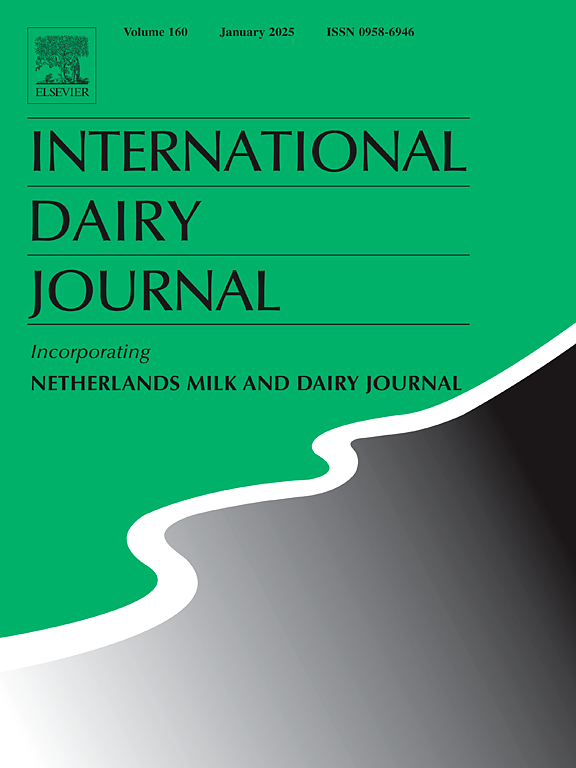产菌性屎肠球菌R9的抑菌活性及细菌素对生骆驼奶微生物种群的影响
IF 3.4
3区 农林科学
Q2 FOOD SCIENCE & TECHNOLOGY
引用次数: 0
摘要
食源性疫情对公共卫生构成严重风险,并对卫生保健系统构成经济负担。细菌素被认为是化学防腐剂的潜在替代品,可以防止和抑制食品中病原体的生长。利用微孔板抑制实验和扫描电镜(SEM)研究了粪肠球菌R9菌株产生的无细胞上清液(CFS)和多种肠毒素的抑菌活性和作用方式。此外,利用Illumina扩增子测序技术研究了肠球菌素对生骆驼奶微生物种群的影响。CFS和肠球菌对广泛的革兰氏阳性和革兰氏阴性食源性病原体均有抗菌活性,包括单核增生李斯特菌、肠炎沙门氏菌、大肠杆菌、大肠杆菌O157:H7和多重耐药沙门氏菌和屎肠球菌。CFS在指数期有抑菌作用,在固定期有杀菌作用,完全抑制单核增生李斯特菌的生长。肠球菌素通过抑菌作用使单核增生李斯特菌的生长减少了80%。扫描电镜显示,CFS通过诱导细菌细胞壁损伤和细胞表面气孔形成抑制革兰氏阴性菌,通过细胞膜裂解抑制革兰氏阳性菌。肠球菌素通过孔形成和细菌细胞壁损伤或细胞裂解对病原体发挥作用。与未处理的条件相比,肠球菌素处理增加了生骆驼奶中细菌属的丰富度和多样性。它们抑制了重要的致病菌,即罗氏杆菌、Paenibacillus、埃希氏志贺氏菌、莫拉氏菌、假单胞菌和沙门氏菌,同时刺激了具有潜在技术相关特征的乳酸菌,即乳球菌和链球菌的生长。本研究表明,CFS和粪肠球菌R9产生的肠球菌素具有广谱抗菌活性,肠球菌素可调节生骆驼奶的微生物种群。这些发现表明肠球菌素可能是控制食源性病原体的潜在天然防腐剂。本文章由计算机程序翻译,如有差异,请以英文原文为准。
Antibacterial activity of bacteriocinogenic Enterococcus faecium R9 and the effect of bacteriocins on the microbial population of raw camel milk
Foodborne outbreaks pose a serious risk to public health and constitute an economic burden on the health care system. Bacteriocins are recognized as potential substitutes for chemical preservatives that prevent and inhibit the growth of pathogens in food. This work aims to study the antibacterial activity and the mode of action of the cell-free supernatant (CFS) and the multiple enterocins produced by Enterococcus faecium R9 strain using the microplate inhibition assay and scanning electron microscopy (SEM). Additionally, the effect of the enterocins on the microbial population of raw camel milk was studied using Illumina amplicon sequencing. The CFS and the enterocins displayed antibacterial activity against a broad spectrum of gram-positive and gram-negative foodborne pathogens, including Listeria monocytogenes, Salmonella Enteritidis, Escherichia coli, Escherichia coli O157:H7, and multi-drug resistant Salmonella and Enterococcus faecium. The CFS completely inhibited the growth of Listeria monocytogenes by exerting a bacteriostatic effect in the exponential phase and bactericidal effect in the stationary phase. The enterocins treatment reduced the growth of Listeria monocytogenes by up to 80 % through a bacteriostatic effect. SEM revealed that the CFS inhibits the gram-negative bacteria by inducing bacterial cell wall damage and pore formation on the cell surface, and inhibits gram-positive bacteria by cell membrane lysis. The enterocins exert their activity on pathogens through pore formation and bacterial cell wall damage or cell lysis. The enterocins treatment increased the richness and diversity of the bacterial genera in raw camel milk compared to the untreated condition. They inhibited important pathogenic bacteria, namely, Rothia, Paenibacillus, Escherichia-Shigella, Moraxella, Pseudomonas, and Salmonella, while stimulating the growth of lactic acid bacteria with potential technologically relevant characteristics, namely, Lactococcus and Streptococcus. This study demonstrated that the CFS and the enterocins produced by Enterococcus faecium R9 exhibit broad-spectrum antibacterial activity, and the enterocins modulate the microbial population of raw camel milk. These findings suggest that enterocins could be potential natural preservatives for controlling foodborne pathogens.
求助全文
通过发布文献求助,成功后即可免费获取论文全文。
去求助
来源期刊

International Dairy Journal
工程技术-食品科技
CiteScore
6.50
自引率
9.70%
发文量
200
审稿时长
49 days
期刊介绍:
The International Dairy Journal publishes significant advancements in dairy science and technology in the form of research articles and critical reviews that are of relevance to the broader international dairy community. Within this scope, research on the science and technology of milk and dairy products and the nutritional and health aspects of dairy foods are included; the journal pays particular attention to applied research and its interface with the dairy industry.
The journal''s coverage includes the following, where directly applicable to dairy science and technology:
• Chemistry and physico-chemical properties of milk constituents
• Microbiology, food safety, enzymology, biotechnology
• Processing and engineering
• Emulsion science, food structure, and texture
• Raw material quality and effect on relevant products
• Flavour and off-flavour development
• Technological functionality and applications of dairy ingredients
• Sensory and consumer sciences
• Nutrition and substantiation of human health implications of milk components or dairy products
International Dairy Journal does not publish papers related to milk production, animal health and other aspects of on-farm milk production unless there is a clear relationship to dairy technology, human health or final product quality.
 求助内容:
求助内容: 应助结果提醒方式:
应助结果提醒方式:


